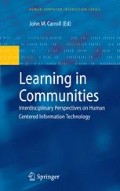Abstract
Universities play an important role in the knowledge society (Brown & Duguid, 2000). Beyond their traditional role in research and education, they have the potential to exploit local knowledge in (regional) innovations and to provide opportunities for students to become lifelong learners.
Access this chapter
Tax calculation will be finalised at checkout
Purchases are for personal use only
References
Arias, E. G., Eden, H., Fischer, G., Gorman, A., & Scharff, E. (2001). Transcending the individual human mind: Creating shared understanding through collaborative design. In J. M. Carroll (Ed.), Human-computer interaction in the new millennium (pp. 347–372). New York: ACM Press.
Bourdieu, P. (1985). The forms of capital. In J. G. Richardson (Ed.). Handbook for theory and research for the sociology of education (pp. 241–258). Westport, CT: Greenwood Press.
Brown, J. S., & Duguid, P. (2000). The social life of information. Boston, MA: Harvard Business School Press.
Bruner, J. (1996). The culture of education. Cambridge, MA: Harvard University Press.
Cohen, D., & Prusak, L. (2001). In good company: How social capital makes organizations work. Boston, MA: Harvard Business School Press.
Collins, A., Brown, J. S., & Newman, S. E. (1989). Cognitive apprenticeship: Teaching the crafts of reading, writing and mathematics. In L. B. Resnick (Ed.) Knowing, learning, and instruction (pp. 453–494). Hillsdale: Lawrence Erlbaum Associates.
Fischer, G., Scharff, E., & Ye, Y. (2004). Fostering social creativity by increasing social capital. In V. Wulf (Ed.). Social capital and information technology (pp. 355–399). Cambridge, MA: MIT Press.
Fischer, G., Giaccardi, E., Eden, H., Sugimoto, M., & Ye, Y. (2005). Beyond binary choices: Integrating individual and social creativity. International Journal of Human-Computer Studies (IJHCS) Special Issue on Computer Support for Creativity (E.A. Edmonds & L. Candy, Eds.), 63(4–5), 482–512.
Huysman, M., & Wulf, V. (Eds.) (2004a). Social capital and information technology. Cambridge, MA: MIT Press.
Huysman, M., & Wulf, V. (2004b). Social capital and IT — Current debates and research. In M. Huysman & V. Wulf (Eds.). Social capital and information technology (pp. 1–16). Cambridge, MA: MIT Press.
Jonassen, D. H., & Mandl, H. (Eds.). (1990). Designing hypermedia for learning. Berlin: Springer.
Lave, J., & Wenger, E. (1991). Situated learning: Legitimate peripheral participation. New York: Cambridge University Press.
Noam, E. M. (1995). Electronics and the dim future of the university. Science, 270(5234), 247–249.
Putnam, R. (1993). The prosperious community: Social capital and public life. American Prospect, 13, 35–42.
Rogoff, B., Matsuov, E., & White, C. (1998). Models of teaching and learning: Participation in a community of learners. In D. R. Olsen & N. Torrance (Eds.). The handbook of education and human development. New models of learning, teaching and schooling (pp. 388–414). Blackwell: Oxford.
Rohde, M., Klamma, R., & Wulf, V. (2005). Establishing communities of practise among students and start-up companies. In Proceedings of the International Conference on Collaborative Learning (CSCL 2005), May 30-June 4 in Taipeh (Taiwan), (pp. 514–519).
Tsichritzis, D. (1999). Reengineering the university. Communications of the ACM, 42(6), 93–100.
Wenger, E. (1998). Communities of practice: Learning, meaning, and identity. Cambridge, UK: Cambridge University Press.
Author information
Authors and Affiliations
Editor information
Editors and Affiliations
Rights and permissions
Copyright information
© 2009 Springer-Verlag London Limited
About this chapter
Cite this chapter
Fischer, G., Rohde, M., Wulf, V. (2009). Spiders in the Net: Universities as Facilitators of Community-Based Learning. In: Carroll, J.M. (eds) Learning in Communities. Human-Computer Interaction Series. Springer, London. https://doi.org/10.1007/978-1-84800-332-3_4
Download citation
DOI: https://doi.org/10.1007/978-1-84800-332-3_4
Publisher Name: Springer, London
Print ISBN: 978-1-84800-331-6
Online ISBN: 978-1-84800-332-3
eBook Packages: Computer ScienceComputer Science (R0)

